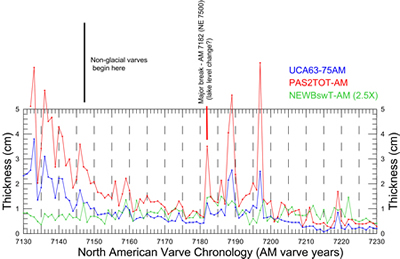Varves of the Month for 11/1/2010 - 11/30/2010
Varves from Newbury, Vermont
This month's varves are thin gray non-glacial varves from outcrop cores at Newbury, Vermont. The varves were collected in 1996 and the split core was partially dried to make the summer and winter layers more easily discernable. The varves on this image have been matched to the North American Varve Chronology (NAVC - AM years). A plot of the varve record from this site (NEWBswT) is matched to a record of Antevs (1922, 1928; UCA63-75) and outcrop cores from the Passumpsic Valley (PAS2TOT), both translated to AM years. The varves on the image were deposited ~13,700-13,500 yr ago when receding ice and glacial melting no longer significantly influenced varve deposition in the valley at Newbury. The receding ice front was likely ~100 km to the north near Colebrook, NH.
The NAVC in the Connecticut Valley shows abrupt changes in varve thickness that are maintained for at least a few decades. These positions in the varve chronology may represent times of lake level change or if varve thickness is not maintained for very long they may represent flood events into the Connecticut Valley from the release of water in tributary lakes. After the recession of ice in the upper Connecticut Valley lake water persisted in the valley after the drainage of the Cold River Stage of Lake Hitchcock and sediment from these lower unnamed lake stages has been cored at Newbury, VT and North Haverill and Hanover, NH. At this point not much is known about the spillways and chronology of these postglacial sub-Cold River lake stages and no names have been given to them.
The varve record from Newbury, as well as the other varve records, show a prominent and abrupt change to thicker varves at AM 7182 (see red bars on image and graph) that represents either the release of water from a lake in the northern Connecticut Valley (Lakes Coos or Colebrook) or a drop in lake level. Prior to the event non-glacial varves are very thin but show a marked change to thicker and sandier varves at AM 7182. The event shown in the core occurs across the entire basin suggesting a lake level change but the varve thickness increase is not permanent and fades after two decades suggesting that it might instead represent a flood event.
Past Varves of the Month...
- 6/1/2008 - Connecticut Valley Varves at Canoe Brook, Dummerston, Vermont
- 4/27/2008 - Connecticut Valley Varves from Kelsey Ferguson Brickyard, Redland Brick Co., East Windsor, Connecticut.
- 7/1/2008 - Champlain Valley varves at Keesville, NY
- 8/1/2008 - Connecticut Valley Varves at Aldrich Brook, Westmoreland, New Hampshire
- 9/1/2008 - Connecticut Valley Varves, Perry Hill Basin (PHS), Charlestown, New Hampshire
- 10/1/2008 - Connecticut Valley Varves, Perry Hill Basin (PHN), Charlestown, New Hampshire.
- 11/1/2008 - Connecticut Valley Varves, Aldrich Brook site, Westmoreland, New Hampshire
- 12/1/2008 - Connecticut Valley Varves, Aldrich Brook site, Westmoreland, New Hampshire
- 1/1/2009 - Mine fire reclamation site, Olyphant, Pennsylvania
- 2/1/2009 - Connecticut Valley Varves, Perry Hill Basin (PHS), Charlestown, New Hampshire
- 3/1/2009 - Connecticut Valley Varves, Perry Hill Basin, Charlestown, New Hampshire
- 4/1/2009 - Connecticut Valley Varves, Perry Hill Basin, Charlestown, New Hampshire.
- 5/1/2009 - Connecticut Valley Varves, Perry Hill Basin, Charlestown, New Hampshire
- 6/1/2009 - Connecticut Valley Varves, Perry Hill Basin, Charlestown, New Hampshire
- 7/1/2009 - Connecticut Valley Varves, Perry Hill Basin, Charlestown, New Hampshire
- 8/1/2009 - Connecticut Valley Varves, Perry Hill Basin, Charlestown, New Hampshire
- 9/1/2009 - Connecticut Valley Varves, Perry Hill Basin, Charlestown, New Hampshire
- 10/1/2009 - Connecticut Valley Varves, Perry Hill Basin, Charlestown, New Hampshire
- 11/1/2009 - Connecticut Valley Varves, Perry Hill Basin, Charlestown, New Hampshire.
- 12/1/2009 - Connecticut Valley Varves, Perry Hill Basin, Charlestown, New Hampshire
- 1/1/2010 - Connecticut Valley Varves, Perry Hill Basin, Charlestown, New Hampshire
- 2/1/2010 - Varves along Starrucca Creek near Lanesboro, Pennsylvania
- 3/1/2010 - Varves in the Don Valley, Toronto
- 4/1/2010 - Varves along Sandy Stream, Dennistown Plantation near Jackman, Maine
- 5/3/2010 - Varves from Glacial Lake Great Falls in Montana
- 6/4/2010 - Varves from Charlestown, NH
- 7/1/2010 - Varves from Redlands Brick Co. (Kelsey Ferguson Brickyard, South Windsor, Connecticut) - A varve that Antevs missed
- 8/1/2010 - Varves from Glastonbury, Connecticut
- 9/1/2010 - Varves from North Hatfield, Massachusetts
- 10/1/2010 - Varves from Newbury, Vermont
- 12/1/2010 - Varves from Newbury, Vermont
- 2/1/2011 - Connecticut Valley Varves at North Hatfield, Massachusetts
- 3/1/2011 - Connecticut Valley Varves Kelsey Ferguson (Redlands Brick Co.), South Windsor, Connecticut
- 6/1/2011 - Connecticut Valley Varves: Core at Scantic, East Windsor, Connecticut
- 8/1/2011 - Varves of West Canada Creek Valley, western Mohawk Valley
- 10/1/2011 - Varves of West Canada Creek Valley, western Mohawk Valley collected in Newport, NY
- 12/1/2011 - Connecticut Valley Varves at Claremont Junction, NH
- 3/1/2012 - Connecticut Valley Varves at Westmoreland, NH
- 7/1/2012 - Connecticut Valley Varves at Rt. 12A drill site in North Charlestown, N.H.




